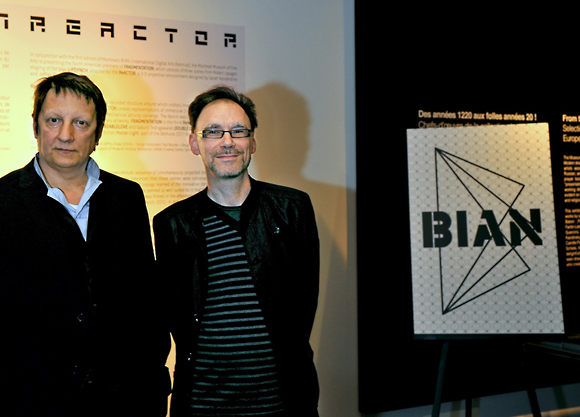
Alain Thibault (Right) with artist Robert Lepage at the opening of BIAN. Courtesy of BIAN 2012. Photo: Conception
Alain Thibault is the founder and artistic director of the International Digital Arts Biennale (BIAN), inaugurating its first edition in April 2012. Unlike his sister electronic music event Elektra, BIAN focuses on digital forms of contemporary art, hosted in numerous museums, art galleries, artist-run centres and other venues throughout the city of Montreal. BIAN invited artists from Germany, Japan, France, Switzerland, Austria, The Netherlands, Turkey, USA as well as Quebec and Canada, including renowned names such as Carsten Nicolai and Ryoji Ikeda. Thibault talked to M-KOS about his motivation to take digital arts to the next level, while he enjoys the taste of success of the first edition of his biennale.
M-KOS [MKOS]: As founder for the International Digital Arts Biennale (BIAN), how would you describe your motivation to do such a festival?
Alain Thibault [AT]: In fact I started out with Elektra in 1999, which is also an international festival of digital arts. The focus with Elektra was mainly about concerts and performances, but still with a mandate of blending experimental electronic music with visuals. This could be audiovisual performance, robotic performance, but there was always a central axis on experimental electronic music combined with a visual element. So that began in ’99, and gradually we evolved out of Usine C which is our main headquarters and quite an extraordinary venue for presenting this type of show. By 2005 we started adding more and more installations to the usual performance program, and these slowly spread to other venues such as the Museum of Contemporary Art in Montreal and the Cinémathèque. In 2009 the installation program exceeded the allocated duration of the whole [Elektra] festival and that was when I said to myself I should make another event out of this, entirely devoted to the installation component. This is more or less how BIAN was born. And also this was about highlighting the idea that we arrived at a point in time where major artists were doing major works [in a digital format] and for me it was important to mark that moment.
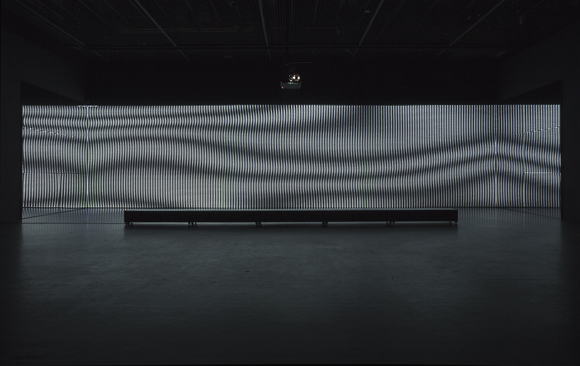
Carsten Nicolai, Unisdisplay, installation view at Museum of Contemporary Art in Montreal, 2012. Courtesy of BIAN 2012. Photo : Richard-Max Tremblay
MKOS: Elektra’s installation program had to take a life of its own?
AT: Yes that’s it. The first major installation presented within Elektra was at the Museum of Contemporary Art in Montreal, an interactive piece by Raphael Lozano-Hemmer, entitled Frequency in Volume, thereafter other installations were developed to exhibit at Usine C. In 2009 we made agreements with various galleries and art centres, to show many installations and mark our tenth anniversary. That’s how things got bigger and bigger with installations.
MKOS: And Elektra is now back to dedicate more performance projects to its program?
AT: Absolutely
MKOS: Now this inaugural edition of BIAN takes Phenomena as a central theme, is the entire biennale program focused on this theme?
AT: Yes. Like any event, you choose a theme and then the works that are really very strong cling to this theme and then there’s stuff in the periphery.

Ashley Fure & Jean-Michel Albert, Tripwire: Out of the blue/Into the black, installation view at the former School of Fine art in Montreal, 2012. Photo : Gridspace
MKOS: And the Biennale is really spread over several locations, over several weeks?
AT: That’s right. We opened on 18 April in a major institution, the Montreal Museum of Fine Arts, with the installation of Robert Lepage. Then later we had a series of openings in galleries and art centres, including Hexagram Concordia, Hexagram UQAM, Carsten Nicolai at the Museum of Contemporary Art was one of our highlights, and then the finale is going to be at DHC/ART with Ryoji Ikeda.
MKOS: Did you also organise performances for the Biennale?
AT: Yes. It started with the Digital Parcours, commissioned by the Quartier des Spectacles, who asked Elektra and Mutek for artistic proposals. We offered Jean Dubois specifically in the Place des Arts, with an interactive installation using mobile phones. We also invited Refik Anadol from Istanbul for a mapping project on the design centre of UQAM. These were artists whose work I really liked and that I wanted to invite for a long time. Fortunately I met Refik at ISEA Istanbul last year, where he created a new piece and here he again produced a new work.
![REFIK ANADOL [TR] EPIPHANEIA - Parcours numeÌrique2_580](http://www.m-kos.net/wp-content/uploads/REFIK-ANADOL-TR-EPIPHANEIA-Parcours-numeÌrique2_580.jpg)
Refik Anadol, Epiphaneia – Parcours numérique, installaton view on a facade of design centre at UQAM, 2012. Courtesy of BIAN 2012. Photo : Martine Doyon
MKOS: Is this the only mapping project we can see at BIAN?
AT: No, actually there are seven altogether. Herman Kolgen on the National Bibliotheque, Yan Breuleux with ElektraTek on the corner of Bleury and Ste-Catherine streets, something interactive at the National Film Board, etc. There will be eight projections in total if we count Jean Dubois.
MKOS: If we include all the public projections, museum events and the exhibitions in artist-run centres, like SKOL, Articule, Clark and Oboro, one could think you have taken the whole city hostage with this Biennale.
AT: Well, everyone, including institutions and smaller galleries alike, was very enthusiastic to participate. Also the timing was good especially because last year the Minister of Culture of Quebec held a consultation to assess the impact of digital arts, and contemporary art venues were called in precisely to encourage them to show more digital art, to present works that are currently being produced within specialized festivals. Like I said it was the perfect time to do this biennale.
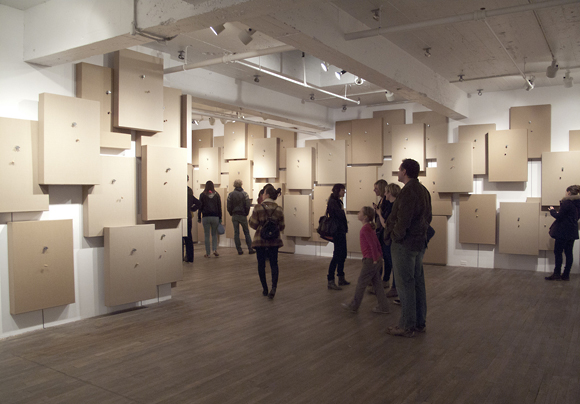
Zimoun + Florian Grond, Le Long de la ligne, installation view at Oboro, 2012. Courtesy of the artist, Oboro and BIAN 2012. Photo : Josée Brouillard
MKOS: When we think about digital arts, an easy assumption is to consider these as a very separate sphere of activity than visual arts, is that fair?
AT: I noticed this differentiation from people who are into visual arts, especially when looking at the differences between works like digital installations and installations in the visual arts. There is, I agree, a misunderstanding which comes from venues blurring the cards when they include projects made by companies who use digital technologies. Those projects are identified as digital culture but they’re really more entertainment products. Meanwhile there are really good digital artworks out there and for me the focus in making the Biennial was to tell people that these works exist, that they must know about them and they must see them.
MKOS: What about the notion of the art object? In visual art, the collectible object is always predominant, inscribed in a market that seems remote to digital artforms which are either quite high maintenance or very ephemeral, thus difficult to consume.
AT: That’s right. The economy is different and that’s why some artists arrange to produce variations of their works. Take someone like Ikeda who will produce a performance, transform the performance into a video installation and even the video installation will be edited into objects, to be sold to collectors. The same happens with Carsten Nicolai. So there are some artists who really do capitalize on that market too. Which is normal.
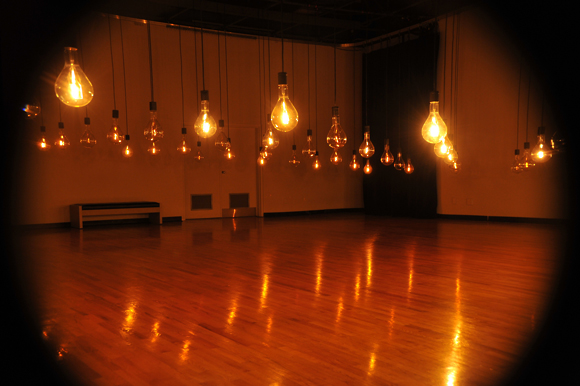
Artificiel, Condemned bulbes, installation view at Maison de la culture Frontenac, 2012. Courtesy of the artist and BIAN 2012. Photo : Conception
MKOS: We are now towards the end of the Bienniale program, have you already started to evaluate its successes and notice some underlying trends?
AT: So far, the general assessment is very good and we see a great amount of interest for this type of art. We noticed this from number of people who showed up at the opening parties, that was undeniable. The response from our partners is also more than positive, and already some are starting to block off the next edition into their 2014 calendar. So we are already working on the second biennial, and so far we are absolutely delighted it has worked so very well. The interest is definitely there, also the public’s curiosity.
MKOS: You already started working on a next edition, is there anything you can hint at in what to expect?
AT: Not yet, no [laugh]. We are still thinking about what to do and many things can change so we would rather not commit to any statement for now. â–
Interviewed by Oli Sorenson (originally in French)
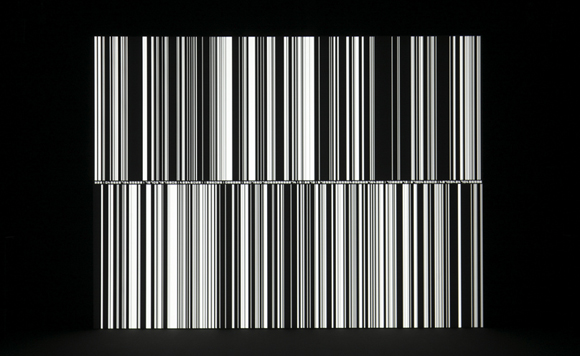
Ryoji Ikeda, Datamatics [prototype-ver.2.0], 2006. © Ryoji Ikeda photo by Ryuichi Maruo courtesy of Yamaguchi Center for Arts and Media (YCAM).
The 1st edition of the International Digital Arts Biennale
Title: Phenomena
18 April – 13 June 2012
Montreal, QC
bianmontreal.ca
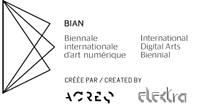
You can see more images from BIAN 2012 on Flickr
